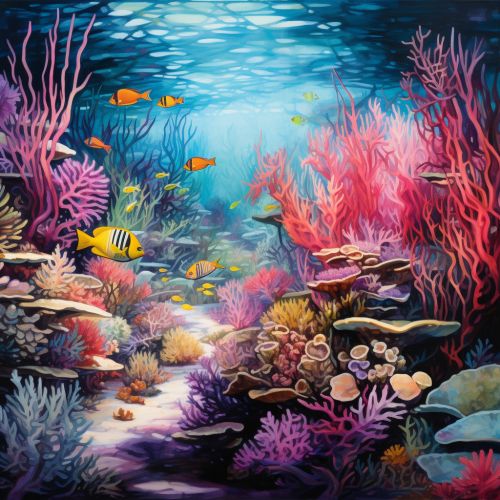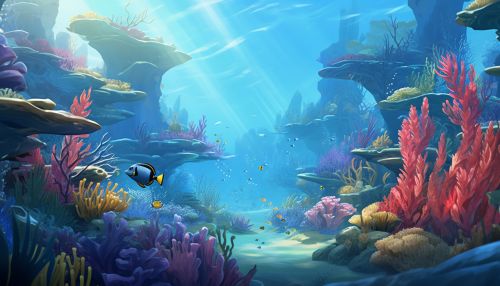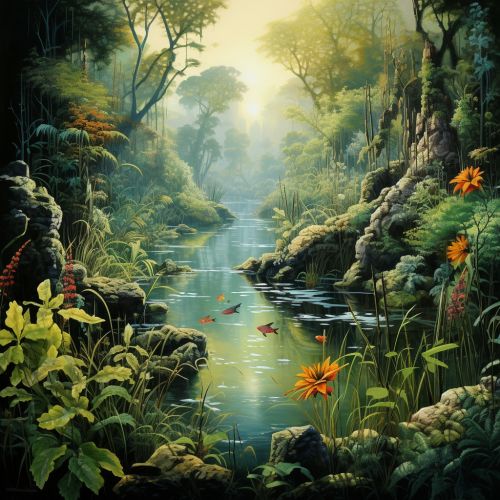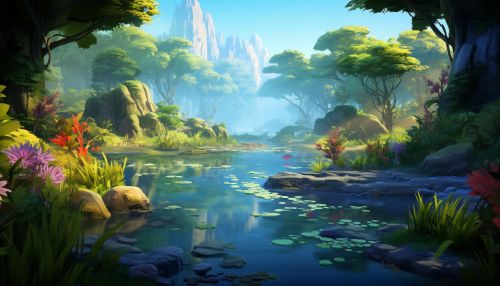Aquatic ecosystem
Introduction
An Aquatic ecosystem is an ecosystem located in a body of water. It represents a complex network of interactions among the living organisms, such as animals, plants, and microorganisms, and their environment. Aquatic ecosystems are categorized as the marine ecosystem and the freshwater ecosystem. They are essential for the overall health of the Earth, playing a vital role in the water cycle, climate regulation, and supporting a vast array of biodiversity.
Types of Aquatic Ecosystems
Aquatic ecosystems are broadly classified into two types: Marine Ecosystems and Freshwater Ecosystems.
Marine Ecosystems


Marine ecosystems cover approximately 71% of the Earth's surface and contain approximately 97% of the planet's water. They generate 32% of the world's net primary production. They are distinguished from freshwater ecosystems by the presence of dissolved compounds, especially salts, in the water. Approximately 85% of the dissolved materials in seawater are sodium and chloride. Seawater has an average salinity of 35 parts per thousand of water. Actual salinity varies among different marine ecosystems.
Marine ecosystems can be divided into many zones depending upon water depth and shoreline features. The oceanic zone is the vast open part of the sea where animals such as whales, sharks, and tuna live. The benthic zone consists of substrates below water where many invertebrates live. The intertidal zone is where the sea meets the land and is affected by tides, waves, and the presence of sunlight for photosynthesis. The neritic zone includes the water that is directly over the continental shelf. The photic zone is where sunlight can penetrate, and photosynthesis can occur.
Freshwater Ecosystems


Freshwater ecosystems cover 0.78% of the Earth's surface and inhabit 0.009% of its total water. They generate nearly 3% of its net primary production. Freshwater ecosystems contain 41% of the world's known fish species. These ecosystems are divided into lentic ecosystems (slow moving water, including pools, ponds, and lakes), lotic ecosystems (faster moving water, for example streams and rivers), and wetlands.
Components of Aquatic Ecosystems
Aquatic ecosystems are made up of biotic and abiotic components.
Biotic Components
The biotic components of aquatic ecosystems can be divided into three groups: producers, consumers, and decomposers.
Phytoplankton and algae are the primary producers in aquatic ecosystems, using photosynthesis to convert energy from the sun into food.
Consumers are divided into primary, secondary, and tertiary consumers. Primary consumers, such as zooplankton and small fish, eat the producers. Secondary consumers, typically larger fish, eat the primary consumers. Tertiary consumers, such as sharks and humans, eat the secondary consumers.
Decomposers, including bacteria and fungi, break down dead organisms and waste materials into nutrients that can be used by the producers.
Abiotic Components
The abiotic components of an aquatic ecosystem include the physical and chemical environment, such as water, light, temperature, and nutrients.
Water is the medium in which all organisms in the ecosystem live. The amount and quality of water in an ecosystem influence the types of organisms that can survive there.
Light is essential for photosynthesis, which is the process by which producers make food. The amount of light that penetrates the water depends on the depth and clarity of the water.
Temperature affects the metabolism of organisms. In general, metabolic rates increase with temperature, but only up to a point. Beyond certain temperature thresholds, organisms may die or fail to reproduce.
Nutrients, such as nitrogen and phosphorus, are essential for the growth of organisms. They are often the limiting factor in the productivity of an ecosystem.
Threats to Aquatic Ecosystems
Aquatic ecosystems are under threat from a variety of factors, including pollution, climate change, overfishing, and habitat destruction.
Pollution from industrial and agricultural runoff can lead to eutrophication, a process that depletes oxygen in the water and can lead to the death of aquatic organisms.
Climate change can lead to changes in water temperature and sea levels, which can disrupt aquatic ecosystems and lead to the loss of biodiversity.
Overfishing can deplete fish populations and disrupt the balance of aquatic ecosystems.
Habitat destruction, such as the draining of wetlands or the destruction of coral reefs, can lead to the loss of biodiversity and the disruption of ecosystem services.
Conservation of Aquatic Ecosystems
Conservation of aquatic ecosystems involves protecting and restoring these ecosystems and the biodiversity they support. This can be achieved through a variety of strategies, including pollution control, sustainable fishing practices, habitat restoration, and the establishment of marine and freshwater protected areas.
Pollution control involves reducing the amount of pollutants entering aquatic ecosystems. This can be achieved through stricter regulation of industrial and agricultural practices, as well as through the promotion of cleaner technologies and waste management practices.
Sustainable fishing practices, such as catch limits and the use of less destructive fishing methods, can help to prevent overfishing and protect fish populations.
Habitat restoration involves the repair of damaged aquatic ecosystems. This can involve the replanting of mangroves, the restoration of coral reefs, or the reintroduction of native species.
The establishment of marine and freshwater protected areas can help to protect biodiversity and preserve ecosystem services. These areas can provide a refuge for threatened species and help to protect critical habitats.
